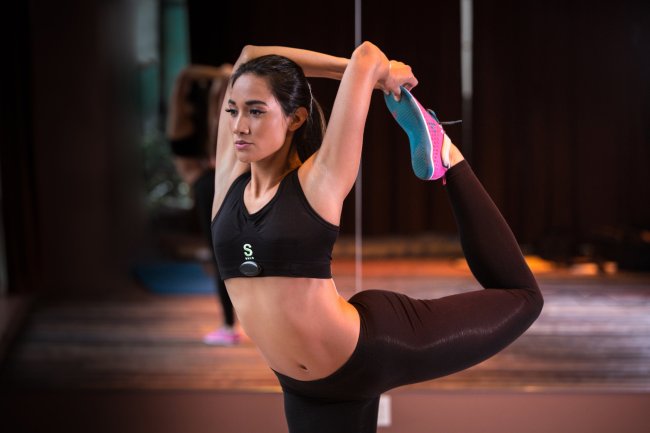 |
The Sensoria sports bra, which has a heart-rate monitor. (MCT) |
Eight kilometers equals approximately 10,000 steps.
How do I know this?
Because just as I made it to the 8-kilometer mark on the Kelly Drive loop Saturday morning, the teeny LED lights in my red Fitbit Flex started doing the happy dance. And the silicone wristband ― reminiscent of cyclist Lance Armstrong’s Livestrong bracelets ― vibrated.
I stopped for a smoothie and did some grocery shopping. And when I got home, I synced the Flex to my laptop and ― drumroll, please ― my grand step total was 18,148. By day’s end, I earned a 20,000-step badge.
Fine, I’m hooked.
So are a lot of other runners, bikers, swimmers, and people just trying to lose a few kilograms, as “wearables” ― computer chips that, at a minimum, track steps taken, distance traveled, calories burned and sleep had ― continue to climb the It-o-meter in fitness and fashion circles.
Fitness tracking chips hit the market in the early 2000s, but they were geared to the techy fitness buff. I once tried attaching a chip made by Nike to my running shoes, but because I couldn’t get the darned thing to sync with my iPod, I threw in the shoelaces pretty quickly. Then they were made to look like pedometers. Clearly, function trumped fashion.
This year, however, sales of activity trackers topped $100 million during the first quarter, according to the market research firm NPD Group. In 2013, total sales were $283 million.
“There’s such a focus on fitness and how it integrates into our lifestyles,” said Ben Arnold, industry analyst for NPD. “Trackers can monitor our heart rate and can tell you how long you’ve been in the sun. The new features are bringing the trackers into the next phase.”
It also helps that the trackers ― the Jawbone, Fitbug, Pulse, Fitbit and market newcomer Misfit Shine ― are becoming trendy must-haves like the recognizable Starbucks coffee cup, Bloomingdale’s brown bag or Lululemon’s horseshoe insignia.
“A Fitbit or (Nike) FuelBand says, ‘I’m active, I like to work out. I’m healthy.’ There is an inherent status symbol in that,” Arnold said.
And where there is cachet to be claimed, fashion is never far behind.
The most talked-about tracker-meets-fashionista collaboration of the year is between San Francisco-based Fitbit and Main Line-bred Tory Burch. Someone on the Tory Burch team, which apparently has a lot of Fitbit wearers, reached out to Fitbit cofounder Eric Friedman. After a few months, the companies settled on a golden cuff bracelet and pendant that can hold a Fitbit sensor.
“These are designed to be high-fashion accessories that can take your Flex tracker from day to night,” said Melanie Chase, product marketing manager at Fitbit.
Misfit introduced its Shine tracker (battery-powered, so it doesn’t have to be charged) in August 2013 with fashion in mind, said founder Sonny Vu.
The circular, hand-polished stainless steel tracker can be attached to a wristband or worn around the neck as a large pendant. It comes in 12 colors, including a blue one that resembles a piece of turquoise.
“It’s perfect for business casual and dressy attire,” said Vu, who introduced a flowery stainless steel necklace holder called Bloom in early May. “We wanted to make something that people would enjoy wearing.”
There’s also a race to marry tracking devices with apparel. Misfit sells T-shirts and socks with snug pockets for the Shine. Seattle-based Heapsylon introduced its Sensoria sports bra and shirt (both $79) earlier this year with sensors embedded in the fabric. Heapsylon will introduce socks in July; four pairs for $199.
The question is: Do trackers provide accurate data?
The consensus is that they work best when worn on the wrist.
By Elizabeth Wellington
(The Philadelphia Inquirer)
(MCT Information Services)








